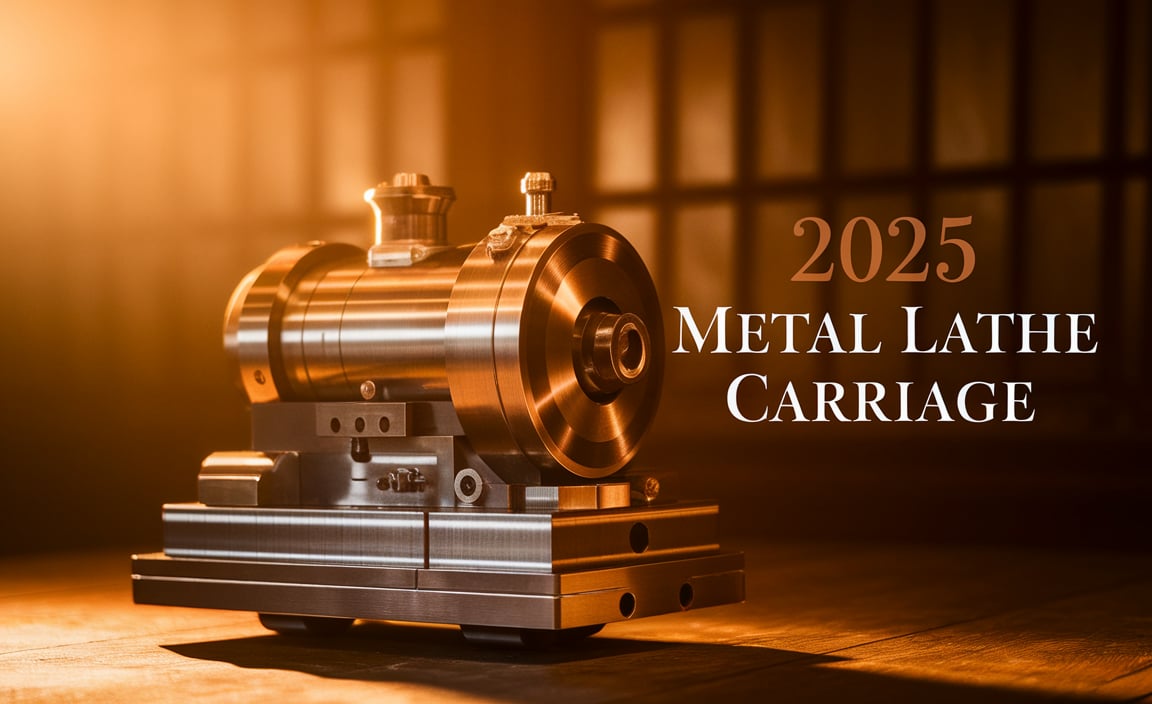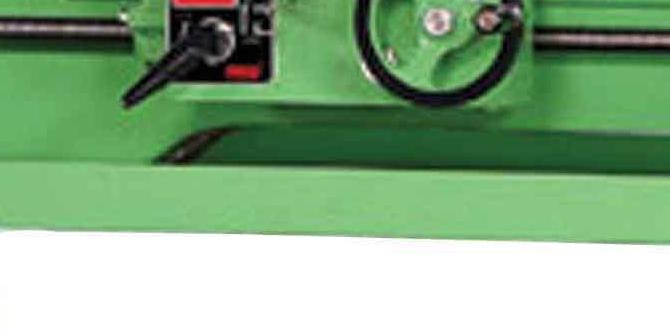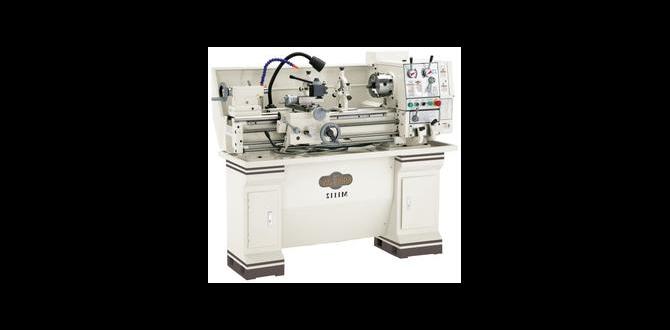Quick Summary:
Carbide cutting tools for lathes are essential because they stay sharp longer, cut harder materials, and allow for faster machining speeds than high-speed steel. Choosing and using them properly dramatically improves your cutting efficiency and the finish of your workpiece.
Carbide cutting tools are a game-changer for any lathe user. If you’ve ever struggled with tools that dull too quickly or can’t handle tougher metals, you’re not alone. Many beginners find the world of cutting tools a bit confusing. But once you understand the power of carbide, you’ll wonder how you ever managed without it. These tools make cutting smoother, faster, and much more enjoyable. Get ready to transform your machining experience!
Why Carbide Cutting Tools Are Essential for Your Lathe
As a machinist, I’ve seen firsthand how the right cutting tools can make or break a project. For beginners on a lathe, especially when working with metal, understanding carbide is a huge step forward. It’s not just about having sharp edges; it’s about having edges that stay sharp and can tackle materials that would quickly wear down other types of tools. This is why carbide cutting tools are considered essential power for any lathe. They represent a significant leap in performance and capability.
The Edge Over Other Materials
What makes carbide so special? It’s all about its incredibly hard nature. Unlike high-speed steel (HSS), which is a common choice for beginner lathe tools, carbide is much harder and can withstand higher temperatures. This means it can cut through tough materials like hardened steel, stainless steel, and exotic alloys with ease. When you’re starting out, you might be working with softer metals like aluminum or mild steel, but as your skills grow, so will the complexity of your projects and the materials you use. Carbide tools ensure your lathe is ready for whatever you throw at it.
Speed and Efficiency
One of the biggest benefits of carbide cutting tools is the ability to machine at much higher speeds. This translates directly into saving time. Imagine cutting a large diameter part; with a sharp carbide tool running at optimal speed, you can remove material significantly faster than with HSS. This increased efficiency is crucial whether you’re a hobbyist trying to finish a project quickly or a professional looking to maximize throughput. Faster cutting also often means a better surface finish on your workpiece, as the tool is less likely to chatter or vibrate.
Durability and Longevity
Carbide tools have a reputation for being durable. While they can be brittle if dropped or subjected to severe shock, their wear resistance is outstanding. This means a carbide insert can often perform the work of many HSS tools before needing replacement or sharpening. For beginners, this translates to fewer tool changes, less frustration, and a more consistent cutting experience. You spend less time worrying about your tool going dull and more time focusing on the precision of your cuts.
Understanding Carbide Inserts vs. Solid Carbide Tools
When we talk about carbide cutting tools for lathes, there are two main types you’ll encounter: carbide inserts and solid carbide tools. Both use tungsten carbide, but they are used differently and have distinct advantages.
Carbide Inserts: The Versatile Choice
Carbide inserts are small, usually triangular, square, or round pieces of carbide that are held in a metal tool body using a screw or clamp. They are the most common type of carbide cutting tool used on modern metal lathes, especially for production work and by hobbyists who want flexibility.
Here’s why inserts are so popular:
- Indexable: When one edge dulls, you simply loosen a screw, rotate the insert to a fresh edge, or replace it. This is incredibly convenient and means you don’t have to grind or resharpen the carbide itself.
- Variety of Grades: Inserts come in different carbide grades, each suited for specific materials and cutting conditions. This allows you to match the tool to your job perfectly.
- Cost-Effective: While the initial cost of an insert and tool holder might seem higher than a simple HSS bit, the longevity and ease of replacement make them very cost-effective over time.
- Specific Geometries: Different insert shapes and chip breakers are designed for specific operations like turning, facing, threading, and grooving.
Solid Carbide Tools: For Specialized Tasks
Solid carbide tools are made entirely from carbide. This includes drills, end mills, and sometimes specialized lathe boring bars or form tools.
When you might see solid carbide:
- Small Diameter Boring Bars: For precise internal cutting, solid carbide boring bars offer rigidity and excellent vibration damping.
- Form Tools: Creating complex profiles can sometimes be done more efficiently with a solid carbide form tool.
- Drill Bits: Solid carbide drill bits are prized for their hardness and ability to drill into very hard materials.
The main drawback of solid carbide tools is that when they are dull, they typically need to be sent out for professional regrinding, which can be expensive or impractical for a hobbyist. For general turning operations on a lathe, carbide inserts are almost always the preferred choice.
Key Carbide Grades for Lathe Machining
The “carbide” material itself isn’t just one thing. It’s a composite material made of metal powders pressed and sintered. The most common ingredient is tungsten carbide particles held together by a binder, typically cobalt. The size of the tungsten carbide grains and the percentage of cobalt binder significantly affect the properties of the carbide. This is what gives rise to different “grades” of carbide, each optimized for different materials and cutting speeds.
For beginner lathe users, understanding a few basic grades can help you make better choices.
General Grade Classifications
Carbide grades are often categorized by color-coding or alphanumeric designations provided by manufacturers. The most common system, developed by the International Organization for Standardization (ISO), classifies them into K, P, M, and H groups.
Here’s a simplified breakdown:
- K-Grade (Blue): These are designed for machining softer, non-ferrous materials like aluminum, brass, copper, and plastics. They have a fine grain structure and are good for achieving a high-quality surface finish. They also resist built-up edge (BUE), where material can stick to the cutting edge.
- P-Grade (Yellow): This is the largest group and is optimized for machining longer-chipping steels and cast irons at higher speeds. They typically have a very fine grain and excellent wear resistance. This is often your go-to for general steel turning.
- M-Grade (Red): These are a ‘universal’ grade, offering a balance between the properties of K and P grades. They are excellent for machining a wide range of materials, including steels, stainless steels, and some non-ferrous metals. If you’re unsure, an M-grade is a safe bet for general-purpose work.
- H-Grade (Green): For machining very hard materials, such as hardened steels (above 45 HRC), high-temperature alloys, and cast irons. These grades are extremely hard but can be more brittle.
The Role of Coatings
Many carbide inserts are coated to further enhance their performance. Coatings add a thin layer of material to the surface of the insert, providing benefits like:
- Increased Hardness: Making the cutting edge even more resistant to wear.
- Reduced Friction: Allowing chips to flow away more easily and preventing heat buildup.
- Improved Heat Resistance: Enabling higher cutting speeds.
Common coatings include:
- TiN (Titanium Nitride): A thin, hard, gold-colored coating. Good for general-purpose machining across steel and cast iron.
- TiCN (Titanium Carbonitride): A harder, darker coating than TiN. Offers better wear resistance, especially for abrasive materials.
- AlTiN (Aluminum Titanium Nitride): Excellent for machining high-temperature alloys and stainless steels. It forms a protective aluminum oxide layer at high temperatures, providing superior heat resistance.
- TiB2 (Titanium Diboride): A very hard coating, good for machining aluminum and other non-ferrous materials, providing an exceptional surface finish.
As a beginner, look for general-purpose M-grades or P-grades, often uncoated or with a basic TiN coating for steel. For aluminum, a specific aluminum-grade insert (often called ‘uncoated’ but might have a TiB2 type coating) will give you the best results.
Essential Carbide Tool Holders for Your Lathe
Just having great carbide inserts isn’t enough; you need the right tool holders to use them effectively and safely. The tool holder secures the insert and mounts it into your lathe’s tool post. The most common system for rectangular shank tool holders is the National Standard (NS) or American Standards Association (ASA) style, and the metric DIN standard.
Understanding Tool Holder Basics
Tool holders come in various shank sizes, typically measured in width and height (e.g., 1/2″ x 1/2″, 5/8″ x 5/8″, 20mm x 20mm). The shank size must match your lathe’s tool post capacity. You’ll also see them designated by a letter, which indicates their function:
- R: Right-hand turning tools.
- L: Left-hand turning tools.
- T: Parting or grooving tools (often have a different parallelogram shape).
- B: Boring bars (smaller diameter bars mounted horizontally or vertically).
Common Tool Holder Types
When you’re starting out, focus on getting a few versatile tool holders.
1. External Turning Tool Holders
These are the workhorses for basic turning operations. They hold inserts for cutting on the outside diameter of your workpiece. You’ll need both right-hand and left-hand holders for different situations. For example, when turning away from the chuck, you’d typically use a right-hand tool.
2. Parting/Grooving Tool Holders
These are specifically designed to cut grooves or to cut a part completely off the stock. They use narrow inserts and have a unique clamping mechanism to hold the insert securely at a precise depth.
3. Boring Bar Holders
For internal machining, you need a boring bar. These are often round bars that fit into a special tool holder that clamps them. They allow you to machine the inside diameter of a workpiece. Some boring bars are solid carbide for rigidity.
4. Facing Tool Holders
While many turning tool holders can be set up for facing (machining the end of the part), dedicated facing tools or inserts might offer better chip control and finish.
Choosing the Right Holder and Insert Combination
Selecting the appropriate insert and holder combination is crucial for successful machining. Here’s a table to help you match them up:
| Operation | Common Insert Shape | Recommended Holder Type | Typical Material Application |
|---|---|---|---|
| External Turning (General) | Round, Triangle, Square (90°) | Right/Left Hand Turning Holder | Steel, Aluminum, Cast Iron |
| Facing | Square (90° or 15°), Triangle | Right/Left Hand Turning Holder (can be adapted) | Steel, Aluminum, Cast Iron |
| Grooving/Parting | Narrow Rectangle | Parting/Grooving Holder | Various metals |
| Internal Boring | Round, Triangle | Boring Bar Holder | Various metals |
| Threading | Specific Threading Insert | Threading Tool Holder | Various metals |
A Note on Tool Holder Systems
Modern lathes often use quick-change tool post systems (like BUEHLER, Aloris, Dorian) which make it very fast to swap between different tool holders. If your lathe has a wedge or piston-style tool post, you’ll likely use a specific type of holder designed for it. For beginners, a simple anvil-style tool post that holds square shank tools is very common and works well with standard rectangular shank holders.
How to Select and Use Carbide Inserts Safely and Effectively
Picking out the right carbide insert and knowing how to use it is key to unlocking its potential. This section will guide you through the selection process and provide essential usage tips.
Steps to Select Your Carbide Insert
1. Identify Your Material: This is the most important step. Are you cutting steel, aluminum, stainless steel, cast iron, or something else? Your material dictates the grade of carbide you need.
2. Determine Your Operation: Will you be turning the outside diameter, facing the end, cutting a groove, threading, or boring internally? Each operation might benefit from a specific insert shape or geometry.
3. Choose the Insert Shape:
Round: Great for general roughing and finishing. Offers good strength.
Square (CNMG, SNMG, TNMG): Versatile for turning and facing. The 90° corner is strong, while a 45° or 15° corner is better for chamfering or lighter cuts.
Triangle (CNMG, TNMG): Good for general turning and facing, especially when a sharp corner is needed for finishing.
Diamond (DCMT, VCMT): Often used for finishing due to their sharper geometry.
* Specific shapes: Like those for threading or grooving.
4. Consider the Cutting Edge Geometry (Rake and Relief Angles): Inserts have specific front and side clearance angles (relief angles) and a top surface angle (rake angle). Positive rake inserts are sharper and take lighter cuts, good for finishing and soft materials. Negative rake inserts are stronger and better for heavy roughing of hard materials. Most general-purpose inserts have a slightly positive or neutral rake.
5. Look at Chip Breakers: Many inserts have a molded chip breaker on top. These are designed to curl the chip into a small “C” or “S” shape, preventing long, stringy chips that can wrap around your workpiece and cause problems. There are different styles for different materials and depths of cut.
6. Check the Coating and Grade: Based on your material (Step 1), select the appropriate ISO grade (P, M, K) and any desired coating (TiN, AlTiN, etc.). As a beginner, an uncoated or TiN-coated M or P grade is a solid choice for steel. For aluminum, look for specific aluminum grades.
Essential Tips for Using Carbide Inserts Safely and Effectively
Safety is paramount when working with any machine tool, and carbide is no exception. Follow these guidelines:
- Secure the Insert Properly: Make sure the insert is seated correctly in the tool holder and clamped firmly. A loose insert can break or be ejected, posing a significant hazard. Always tighten the clamp screw with the correct tool.
- Use the Correct Tool Holder: Ensure the insert fits the pocket designed for it in your tool holder. Different insert shapes and sizes require specific holders.
- Set the Tool Height Correctly: The cutting edge of the carbide insert should ideally be set at the same height as the center of the workpiece. Setting it too high or too low can lead to poor cutting performance, premature tool wear, or even damage to the machine or workpiece.
- Begin with Conservative Speeds and Feeds: While carbide allows for high speeds, start with what the manufacturer recommends or a conservative estimate (e.g., for steel, start around 200-300 surface feet per minute or SFM, which is roughly 60-90 meters per minute or m/min). You can increase speed and feed later if the cutting action is smooth and the finish is good. A good rule of thumb for feed rate on steel with general inserts is often around 0.005” to 0.010” per revolution (0.12 to 0.25 mm per revolution).
- Use an Adequate Depth of Cut: Carbide typically excels at taking moderate to heavy cuts. For roughing, try at least 0.080″ (2mm) to 0.120″ (3mm) depth of cut on a medium-sized part, provided your machine has the power and rigidity. For finishing, use a much lighter cut, like 0.005” to 0.010” (0.12 to 0.25mm).
- Coolant is Your Friend: While carbide can handle heat better than HSS, coolant still plays a vital role. It helps to:
- Keep the insert and workpiece cool, extending tool life.
- Flush chips away, preventing them from recutting.
- Improve surface finish.
If you can’t use a flood coolant system, a spray mist or occasional manual application is better than nothing.
- Listen to the Machine: Pay attention to the sound of the cut. A smooth, consistent slicing sound is good. A squealing, chattering, or grinding noise indicates a problem – possibly incorrect speed, feed, depth of cut, a dull tool, or a vibration issue.
- Avoid Shock Loads: Carbide is hard but can be brittle. Avoid sudden impacts, like plunging too quickly into a shoulder or encountering a hard spot in the material. Ramming the tool post into something is also a recipe for disaster.
- Inspect Inserts Regularly: Even with carbide, edges eventually



